
|
|

|
Table of Contents:
- Symposium comments from Black Lion, Black Stag, and Æstel
- Think Small
- The Standard
- Avoiding the Silhouette Syndrome
- The An Tir Internal Letter of Intent
- LoAR Comments/Results
- March Lion's Blood Meeting Results
- New Submissions
- Return to the IL Archive Page
From Black Lion Principal Herald regarding Symposium
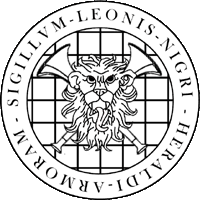
In a word... success!!
I had a great time up there, Avacal are great hosts and judging by the sizes of my classes, hungry for heraldry.
Special thanks goes to Morel for laying such a phenomenal groundwork that it went off with nary a hitch, despite the fact that circumstances did not allow her to attend. Morel, you did a great job, everything went great!!
Other thanks go to Viscount Steinn for suggesting the idea, and supporting it strongly. Aramatus, the site autocrat, did a great job (especially for his first event to autocrat..), and the wonderful hosts Baron and Baroness Raul and Roxanne of Myrgan Wood. Extra thanks for the colorful native guiding of Master Micheal.
The teachers and support staff who traveled so far, and gave so much of them selves for this event: Elizabeth Pomegranate, Christopher Queue Forchee, Meadhbha Dragons Mist, Francesca stal, Ciaran Goutte de Sang.
To Laurel-designate Shauna and Athenais Black Pillar Herald (Artemisia) who came and taught, an extra big thanks for the support!
If I forgot anyone, it is not intentional, just tiredness speaking.
We did good work up there, and there was a heraldic gleam in a number of eyes when we left.
Huzzah!
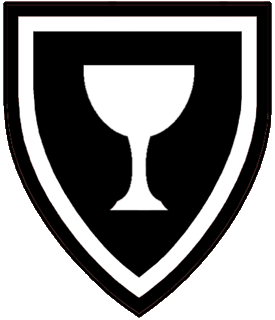
Yours in Service
Frederic Badger
Black Lion Principal Herald
Arms: Sable, a chalice within an orle argent.
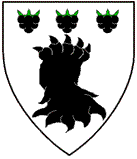
Response from Black Stag
You're quite welcome! But, the paperwork would not have gotten there (it was in my luggage, ready to be transported by me) if it wasn't for the autocrat adding a last minute job to his harried schedule. I emailed him all the files, he printed them off and got them to the site. What chaos if he hadn't jumped in! And thanks so much to you, Badger, for taking over without hesitation when I couldn't get there. I can't tell you how very much I appreciated that.
I was so frustrated at not being there after all of the built up excitement, but I am so gratified that I could at least *know* that all was still going well. Armatus had done much to ensure that this event would be fun, and I knew that all of the teachers and support staff had enough experience to carry it all off.
I want to add my thanks to all of you who traveled so far (over 1200 miles each way!) to give of yourselves in time, effort and experience. I've heard from Armatus that you left such a wonderful and positive impression on the folks of Avacal. You're all heroes in my book!
Morel
Argent, a bear's jambe erased, in chief three blackberries sable hulled vert.
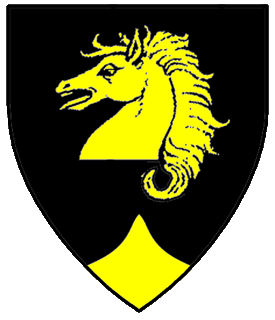
Æstel adds to the subject of Symposium
Many thanks to all those who helped make this year's Heraldic Symposium a smashing success! Thanks to the good folk of Myrgan Wood, especially Lord Armatus (autocrat, crash-space provider, and general dog's body for the event) and Master Michael (colorful local guide extraordinnaire), to Muirgheal Black Stag who displayed a fine flexibility as things shifted up to the last minute, and to all the heralds who traveled to teach, consult, and generally encourage our cousins in north-eastern An Tir! Thanks also to Baroness Roxanne for making sure the event staff had food and drink, and to various local members who made coffee runs that were much appreciated.
Sadly, her ladyship Muirgheal was unable to attend due to a long delay of her connecting flight. She emailed last minute paperwork to Lord Armatus, who carried on without a hitch. Another cheer for Armatus!
The symposium was well and enthusiastically attended in a pleasant set of classrooms at the University of Saskatchewan. Once again, Mestra Rafaella d'Allemtejo arms exemplars were deployed to decorate and help teach. Most of the classes were packed to overflowing. Naturally, the best decorated -- and one of the very heavily attended -- was Heraldic Display. Countess Elisabeth, with items from many sources, put on a fine show of items exalted and humble decorated with armorial motifs. Many seemed motivated to go forth and enhance with heraldry!
The consult table was even more fun than usual. I learned more about how to have fun being an encouraging consult herald from watching Countess Elisabeth deploy her people skills, and from watching Lady Meadhbha quietly put people at ease, and help them to understand the process -- and from just generally watching all the different consulting styles of Mistress Shauna, Lady Athenais, Lord Ciaran, and Lord Christopher Thomas. Lord Badger reported great success with his non-heraldic cultures presentation. All in all, I think we pleasantly surprised a good number of people who seemed to come willing to work with us, but not very confident that they could have what they wanted or anything very like it.
If I've left off someone's name, pray accept my apology!
The folks in Saskatoon are great cooks! We waddled out of the feast hall after beer and cider (buy your own, but there it was!) salad, excellent roast beast, tandoori chicken, two marvelous soups, very good bread and garlic- or honey-butter, some wonderful short-bread cookies, and I've no doubt forgotten some other goody.
I can also report an easy, pleasant and completely non-eventful border crossing into Canada. When asked the purpose of our trip, we replied that we were attending a conference of fellow club-members interested in medieval heraldry. The nice gentleman seemed perfectly content. He looked at our proofs of origins, asked a few questions, and passed us through without paying the least attention to the library tubs. Of course, he may not have realized they were there, since he didn't ask us to open the car, and we had all kinds of coats, coolers, drinks and munchies on top, after a day and a half of travel.
The crossing back through officious U.S. customs was somewhat less pleasant, but still accomplished with little fuss. Smile. If they're condescending or not terribly polite, smile anyway and let's just get gone.
E'en so, 'twas a trip well worth the making. I heartily encourage all who can to reach out to the far areas of the kingdom. We have good people out there who need a little encouragement. If you can't go in person, mayhp you can mentor someone electronically.
I am proud to be associated with you all!
Francesca Testarossa dei Martini
Æstel herald
Sable, a horse's head couped and a chief Or.
Think Small
The miniature emblazon on a submission form must be a reduction of the full-sized line drawing copy, not a redrawing. The version of the emblazon seen by the Colleges of Heralds and Arms must be exactly the same picture as is on the full-sized colored emblazon that Laurel will rule upon. Without a true version of your emblazon for the Colleges to comment on, correct information regarding style and conflict may not be available, and Laurel will return submissions that cannot be correctly checked by the College of Arms. Please make sure your submissions and those of your clients have miniature emblazons that are exact copy reductions of the full sized line drawing emblazon; either photocopy reduction or computer reduction (retaining proportions and without fuzziness, please) are acceptable. Forms problems are a stupid reason for returns to occur because they're all preventable.
The Standard
[Čtendard (French), estandarte (Spanish), standart (German), shtandart (Russian), estandarte (Portuguese), stendardo (Italian), estandart (Danish), standaard (Netherlands), vaandel (Belgium)]
an article by Monsignore Michele Aquilani da Napoli
The standard is commonly defined as an identifying flag, representing a military unit or person, based upon heraldic blazon and around which people rally. It was sometimes displayed in tournaments but its primary function was on the war field. In English it is first referenced to Northallerton in 1138 ("the Battle of the Standard"). The height of its popularity was around the 14th century and did not last past the Tudor period except for ceremonial purposes.
There are explicit rules as to what can be displayed on the standard. Typically it was of pennon shape tapering at one end and varying in size. The standards of gentlemen would have an undivided end (figures 2b-2e), whereas those of the rank (knight and above) would have split, swallow-tailed ends (figure 4b). The length of the standard also indicated rank. A Royal's standard was 30 feet in length, a Duke's standard was 21 feet in length, a Viscount's standard was 16 feet in length, and a Knights standard was 12 feet in length. The general practice for everyone else seemed to be 8 feet in length.
The hoist of the standard (dexter side, occupying less than 1/3 of the standard) was typically reserved for the national flag, i.e., the attributed arms of St. George (figure 3b) for England or the attributed arms of St. Andrew (figure 3c) for Scotland. Since the 20th century, the arms of the bearer have commonly been shown in the hoist section (figures 1e-3e). Within the SCA it is conventional to place the Kingdom colors in the hoist section of the standard (figures 1d-3d).
 Figure 1a
Figure 1a
Graf Sir Berek von Langental
Azure, ermined argent, on a cross argent a walnut wood mug proper, headed argent.
- Member of the Order of Chivalry
- Member of the Order of the Pelican
- Lion of An Tir
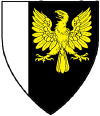 Figure2a
Figure2a
Monsignore Michele Aquilani da Napoli
Sable, an eagle Or and a dexter tierce argent.
- Member of the Order of the White Scarf
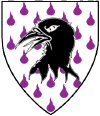 Figure3a
Figure3a
Lady Marya Kargashina
Argent goutty purpure, a raven's head erased sable.
The remainder of the standard was typically split per fess with the owners' tinctures and the main charge or badge placed on the banner facing the hoist (figure 4a) . If just the owners' livery colors wished to be represented, then the color of the charge was placed above that of the main field color and the main charge or badge would be forgone (figures 2c-3c).
A motto typically was positioned bendwise, which divides the standard into compartments (figures 1b-3b). Since the 20th century, the crest and badge has been alternated between these compartments (figures 1e-3e). Finally the entire standard edge was fringed with the livery colors giving it a bordure company effect (figure 4b).
Above all else, the design of the standard must not interfere with the clarity or the heraldic character of the charge.
Devices (figures 1a-3a) have been used with the expressed permission of their bearer. However, nationality of the bearer's persona has not been taken into consideration when designing these examples. The bearers were not consulted in regards to their preference of badge or motto, nor were any augmentations of arms registered at the time, although it is known that they have been awarded.
 Figure 1b
Figure 1b
Graf Sir Berek von Langental's standard, displayed with a Landsknecht (in Imperial service) nationality, dexter charge, augmentation of arms and motto "Ich Dein". The standard would be 19 feet in length with a swallow-tailed end.
 Figure 1c
Figure 1c
Graf Sir Berek von Langental's standard, displayed as a Landsknecht (in French service) nationality and augmentation of arms. Displayed without the charge and with only the livery colors. No color of the charge would be used since it is blazoned proper. The standard would be 19 feet in length with a swallow-tailed end.
 Figure 2b
Figure 2b
Monsignore Michele Aquilani da Napoli's standard, displayed with an Imperial (Holy Roman Empire) nationality, charge and motto "Dominus Illuminatio Mea". The standard would be 8 feet in length with an undivided end.
 Figure 2c
Figure 2c
Monsignore Michele Aquilani da Napoli's standard, displayed with a Venetian nationality. Displayed without the charge and with only the livery colors (main charge color on top and the main field color on bottom). The standard would be 8 feet in length with an undivided end.
 Figure 3b
Figure 3b
Lady Marya Kargashina's standard, displayed with English nationality, charge and motto "At Your Peril Be It". The standard would be 8 feet in length with an undivided end.
 Figure 3c
Figure 3c
Lady Marya Kargashina's standard, displayed with Scottish nationality. Displayed without the charge and with only the livery colors (main charge color on top and the main field color on bottom). The standard would be 8 feet in length with an undivided end.
 Figure 1d
Figure 1d
Graf Sir Berek von Langental's standard, displayed with SCA-An Tir nationality, dexter charge, motto "Ich Dein" and without an augmentation of arms. The standard would be 19 feet in length with a swallow-tailed end.
 Figure 1e
Figure 1e
Graf Sir Berek von Langental's standard, displayed modernly with personal device, alternating dexter charges, augmentation of arms and motto "Ich Dein". The center badge displayed is for membership in the Order of the Pelican. The standard would be 19 feet in length with a swallow-tailed end.
 Figure 2d
Figure 2d
Monsignore Michele Aquilani da Napoli's standard, displayed with SCA-An Tir nationality, charge and motto "Dominus Illuminatio Mea". The standard would be 8 feet in length with an undivided end.
 Figure 2e
Figure 2e
Monsignore Michele Aquilani da Napoli's standard, displayed modernly with personal device, alternating charges and motto "Dominus Illuminatio Mea". The center badge displayed is for membership in the Order of the White Scarf. The standard would be 8 feet in length with an undivided end.
 Figure 3d
Figure 3d
Lady Marya Kargashina's standard, displayed with SCA-An Tir nationality, charge and motto "At Your Peril Be It". The standard would be 8 feet in length with an undivided end.
 Figure 3e
Figure 3e
Lady Marya Kargashina's standard, displayed modernly with personal device and repeating charges and motto "At Your Peril Be It". The standard would be 8 feet in length with an undivided end.
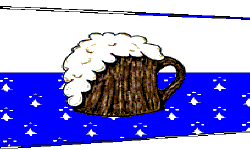 Figure 4a
Figure 4a
Graf Sir Berek von Langental's
charge is rotated towards the
hoist (dexter) on the standard.
 Figure 4b
Figure 4b
Graf Sir Berek von Langental's standard shows a swallow tail
due to rank and has a bordure compony effect when fringed with his livery colors.
References:
Dictionary of Heraldry, Brockhampton Reference, 1997
A Complete Guide to Heraldry, A.C. Fox-Davies, 1993 (reprint of 1909 edition)
The Art of Heraldry, A.C. Fox-Davies, 1986 (reprint of 1904 edition)
The Complete Book of Heraldry, Stephen Slater, 2003
The Glossary of Flag Terms, Flags of the World (http://fotw.unislabs.com/flags/flagglos.html)
"Standards and Pinsils and Pennons, Oh My!", Mistress Elizabeth Braidwood (http://www.kwantlen.ca/~donna/sca/flags)
College of Arms (http://www.college-of-arms.gov.uk)
Avoiding the Silhouette Syndrome
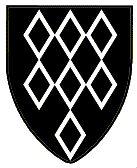
Your charge is sable, but there's internal detailing. How do you render it so that it's elegant and recognizable rather than a big black blob? Here are some hints I've gathered over the years:
- Gel pens usually go on over black marker just fine and stay visible - silver is better than white because white can disappear, or gold works if you want to compliment the Or in your armory. Note that gel pens ONLY work well for detailing, never large areas (believe it or not, the ink cracks and falls off with age or temperature changes of over 10 degrees C).
- Liquid correction fluid (White-Out, Liquid Paper, etc.), especially when it comes out of a 'correction pen', makes good detail marking on black.
- Don't color the detail lines. This is a terrific way to make yourself stark raving mad, but I've seen it done successfully.
- If the silhouette of the charge is identifiable, don't sweat the lack of internal detail. I don't suggest that with any but the most obvious of charges, however, because it just looks bad and identifiability is one of the top requirements for armory. Be cautious; lack of identifiability might cause a return.
- Use black from your printer but no other colors, then use markers to color in the rest of the device. Black ink only very rarely turns on submission forms (when it does it goes either charcoal or mossy gray-green) and is usually trustworthy and then your computer can include the white detail lines. Laurel will NOT return armory that isn't entirely marker-colored (this has been a myth circulating for a couple of months - please help squelch it) providing the tinctures are unambiguous and identifiable and there are no problems with pixilated lines looking like fimbriation or blurring the design too badly. Markers are recommended, not required (however, after watching 13 months' worth of submissions from all kingdoms, I'll add that they're the best possible way to avoid tincture problem returns and that nothing matches their true colors and durability). So printing the black is perfectly permissible.
Teceangl
Ounce Herald
An Tir Internal Letter for April, AS XXXVIII / 2004 CE
| Lady Marya Kargashina lions-blood@antir.sca.org |
April 30, 2004 Send thy comments here: | Jessica Smith-Carlock 5114 SE Holgate Portland, OR 97206 503-772-0002 |
Commentary on this Letter will be due June 17th, 2004.
(Send comments to Lions Blood Herald, information at top of this page)
* * * Change of April Lions Blood meeting venue * * *
The May Lions Blood meeting will be held on Sunday, May 16th, at the home of Christopher Queue Forchee: 7757 40th Ave. NE, Seattle, WA 98115. The house is in the Wedgwood area, East of Ravenna, North of UW.
Directions:
By Bus: Bus route 71 stops at the end of my driveway, tell the driver you want to get off at 80th St. Bus route 65 stops on NE 80th St & 35th Ave NE, walk 5 blocks east on 80th.
By Car: ** IMPORTANT PARKING NOTE **
The curb in front of my house, and the space directly across the street from it is a bus stop. Don't park there, even though the paint is faded. Easiest parking is on NE 80th St., on the side of the house.
From the South I-5 *Express Lanes*: Take the Lake City Way exit (it's a left-ramp off the freeway). Get into the Right lane of the ramp as soon as possible after exiting the freeway. Turn Right at the first light (NE 80th St). Note: NE 80th does not go through to my house, there's stuff in the way, so... Turn Right at the first 4-way stop (20th Ave NE.). Turn Left at the first light (NE 75th St). Follow the "From NE 75th St" directions, below.
From the South via I-5 (incl. 520 & 90): Take I-5 to exit 171 (522, Bothell). Stay to the right hand of the ramp. Just as the ramp goes around a bend there will be an exit to your Right. Take it. Merge into 73rd heading East (only option). Stop at the stop, stay on 73rd. Turn Left at the next stop sign, onto 12th, heading North again. Turn Right at the light, onto NE 75th St., heading East again. Follow the "From NE 75th St" directions, below.
From the North via I-5: Take the exit for 80th St. & 85th St. Follow the signs for 80th St. East Bound, turning left at the end of the ramp. You will cross over I-5. Continue on 80th St. for a while. Turn Right (south) @ the 4-way stop on 20th Turn Left (east) @ the first light (NE 75th St.). Follow the "From NE 75th St" directions, below.
From NE 75th St: Turn Left at the 4-way stop (onto 40th Ave NE). Go two short "blocks." The house will be on your Left just as the school yard ends, on the corner with NE 80th St. If you completely pass the school yard, or cross over 80th St., you've gone too far.
The June Lions Blood meeting will be held. Date and location TBA.

Greetings from Lions Blood.
I have had a rash of otherwise fine submissions with assorted admin problems. Please remind your clients of these things in particular:
- First, we require THREE copies of everything.
- Second, the check/money order must NOT be made out to myself, but instead to "College of Heralds, An Tir, SCA inc."
- Third, please use MARKERS; everything else has its own problem. Color copies are particularly a problem; I just received a pinky purple 'Gules' which I doubt started that way.
МАРЫА КАРГАШИНА (Marya)
From the Cover Letter to the January 2004 LoAR (printed on March 31, 2004, narrowly missing 1 April):
From Laurel: No Quarter
In the spirit of the day after the nominal print date of this cover letter, we should issue a warning about The Quarter, http://www.thequarter.org/. It is an SCA newsletter completely devoted to humor and satire. Those incautious enough to read it while drinking may hurt their nasal passages and their keyboards, and anyone else may be driven to drink. This newsletter takes especial pleasure in poking fun at heralds and revealing our secrets. Laurel and Laurel staff have even been deceived by their irony.
Therefore, we are putting http://www.thequarter.org/ into Administrative Handbook Appendix X, "Index Librorum Prohibitorum" ("Index of Prohibited Books"). All heralds are formally enjoined from reading it without prior written permission from Laurel. Laurel expects this injunction to be observed as rigorously as the last time Laurel "formally enjoined" something in Trimaris (LoAR of December 1992).
An Tir results from the LoAR dated September 2003 (see the LoAR for full text):
(typos might exist - only the LoAR itself is definitive; other than name, action and blazon, listings are paraphrased or abridged)
REGISTERED:
- Aedan MacEwan. Name change from Aedan Haukesblod (see RETURNS for device).
His previous name, Aedan Haukesblod, is released. - Aedan MacEwan. Alternate name Aedan the Silent.
- Brynach ap Rhys. Badge. (Fieldless) A bow reversed gules.
- Cadoc Godeboldus. Name and device. Per bend sable and argent, a goblet Or and a sword gules.
- Christopher MacEveny. Device. Vert, a merman proper crined Or tailed azure maintaining a horn in his dexter hand and a trident in his sinister hand all issuant from a base wavy Or.
The merman is in his default affronty guardant posture. For mermen and mermaids, this posture is often tilted slightly to the side rather than fully affronty: this is a standard period way of drawing merfolk. The hair color of the merman was not blazoned in the Letter of Intent, but was blazoned on the submitter's form. Since the Pictorial Dictionary notes that the hair color of merfolk proper is usually blazoned explicitly, and the submitter did so on the original blazon, we have done so here.
Some commenters mentioned the fact that the merman has his tail reflexed up in a 'u' in this emblazon. The main body of the merman through the top of his tail (where his hips would be if he had them) issues from the base, and the end of his tail also issues from the base, and these two pieces of the merman are not conjoined to each other. This is an acceptable way of drawing a merman issuant from a base. It is analogous to the period practice of drawing a demi-lion issuant from a line of division so both the demi-lion and the end of the demi-lion's tail are issuant from the line of division and are not conjoined to each other. It is the choice of the heraldic artist to decide whether to draw the merman in this fashion, whether to draw him so that his body and tail end are conjoined, or to draw him without the tail tip showing at all. - Conall Mac Quharrie. Name.
Submitted as Conall Mac Quarrie, no documentation was found that MacQuarrie is a period form. All of the examples of this name found in period, both presented in the LoI and those found by the College, that are spelled -Qu- also include the -h- in the middle of the name. As an example, Black (p. 558 s.n. MacQuarrie) dates the form McQuharrie to 1573. We have changed the byname to the form Mac Quharrie, a plausible period form based on the example from Black, in order to register this name. - Duncan Darroch. Device. Argent, two compass stars in fess and on a point pointed ployé vert a compass star argent.
- Eden Kent. Device. Per pale argent and gules, in fess a radish gules leaved vert sustained by a bat-winged rabbit rampant Or all within a bordure sable.
- Eden Kent. Badge. (Fieldless) In fess a bat-winged rabbit contourny sustaining a radish leaved Or.
- Everild le Kembere. Name.
- Halldórr hálfskeggr. Name and device. Vert, a sword inverted argent between flaunches Or each flaunch charged with a drinking horn point to center sable.
Submitted as Halldórr halfskeggr, Old Norse names are registerable with accents used or omitted consistently throughout the name. As the given name included accents, we have added the missing accent to the byname. - Hans Dürrmast von der Wanderlust. Badge. (Fieldless) A mullet of five greater and five lesser points within and conjoined to an annulet argent.
He has a letter of permission to conflict from Alexandre sur la Mer, Azure, a compass rose argent. - Jocelyn Montgomery de Lyons. Name.
- Kateryne of Hindscroft. Badge. (Fieldless) A cat sejant contourny purpure.
- Keterlin von dem Drachen. Name.
- Muriel Rose de Wessex. Name and device. Vert, on a pale between two greyhounds rampant Or three fleurs-de-lys azure.
- Raffe Ó Donnabháin. Name (see RETURNS for device).
- Rohesia Morleigh. Name.
Submitted as Rohesia Moreleigh, the submitter requested authenticity for 12th to 14th C English and allowed minor changes. No documentation was presented and none was found that Moreleigh is a period form of this placename. The LoI stated that "Moreleigh is cited from P.H. Reaney & R.M. Wilson, Dictionary of English Surnames, pg 314, sub Morley, dating Moreleigh to 1377." This statement is in error. The name dated to 1377 at this location in Reaney & Wilson is Thomas Morleigh. We have changed the submitted byname to Morleigh to match this documentation and to meet the submitter's request for authenticity. - Rowena Kyncade. Name.
- Styrkárr Bjarnarson. Name change from holding name Styrkárr of Aquaterra.
- Symmonne Deccarrette de Villette. Name change from Darbie of Ironmaid and device change. Argent, two dragons combattant tails nowed to base in a Ormond knot the dexter dragon gules and the sinister dragon sable and in chief a flame per pale gules and sable.
Her previous alternate name, Symmonne Deccarrete de Villete, is released.
Her previous primary name, Darbie of Ironmaid, is retained as an alternate name.
The dragons were originally blazoned as breathing flames. Even though the flames breathed by a dragon are usually not large (and are considered too small to be worth difference), these minute wisps of flame are so insignificant that we have omitted them entirely from the blazon.
The submitter asked that the tails of the dragon be blazoned as nowed in an Ormand knot [sic]." The SCA usually uses the term Wake knot for this knot, but the term Ormond knot is found as a synonym for this knot in standard real-world and SCA sources (Brooke-Little's An Heraldic Alphabet and the Pictorial Dictionary). Since the submitter wants to use this alternate name for the knot, we have acceded to her request, although we have fixed the spelling of the knot to the documented spelling Ormond Knot.
Her current device, Per pale sable and argent, two dragons statant erect respectant counterchanged breathing flames proper, a chief per pale ermine and counter-ermine, is retained as a badge. - Tacye Maple. Device. Purpure, a catamount sejant guardant Or charged on the shoulder with an ermine spot sable and on a chief invected Or three maple leaves gules.
- Tamlin Mac Gryhme of Westray. Name.
Submitted as Tamlin Mac Grim of Westray, no documentation was found to support Mac Grim as a plausible spelling in period. Woulfe (p. 545 s.n. Ó Gréacháin) lists O Gryhme as an Anglicized Irish surname dated to temp. Elizabeth I-James I. Based on this example, we have changed this name to Mac Gryhme in order to register this name. - Wolfker Krieg von Lindenthal. Name and device. Per pale sable and argent, two wolves combattant counterchanged within an orle gules.
RETURNED:
- Aedan MacEwan. Device. Vert, a natural tiger displayed Or marked sable within a bordure rayonny Or.
The tiger was blazoned on the LoI as statant erect affronty, but no evidence was presented, and none was found, indicating that this is a period posture. Note that statant erect is a rare posture in period that is used almost exclusively for bears, and sejant erect affronty is an even rarer posture in period. Because these two postures are so rare, we do not believe that statant erect affronty can be reasonably extrapolated to be a period-compatible posture. None of the commenters who discussed the armorial style of this submission were comfortable with considering the posture of this tiger to be period style. We therefore will not be registering this posture now or in the future.
Much of the commentary suggested that the tiger is in the displayed posture, so we have blazoned it using that term. However, displayed is also not an appropriate posture for wingless quadrupeds. Per the LoAR of July 1995, p. 2, "The bear was blazoned as statant displayed in the LoI, but there was a consensus among the commenters that displayed is an avian posture inappropriate for beasts (as, for example, rampant is a quadrupedal posture inappropriate for birds)."
Note that the bear in the July 1995 submission referenced in the precedent above was in fact registered and blazoned with the statant erect affronty posture, rather than being reblazoned as displayed and returned for non-period style. However, the College has benefited from much research and learning during the years since that ruling, and its opinions have changed. In fact, al-Jamal, who was the Laurel who wrote the July 1995 ruling, commented on the current submission as follows: "Okay, I suppose it can be argued that it is only one step from a period leonine posture (sejant erect affronty), but that posture is very rare, and this one has not been noted in period heraldry, and is effectively 'displayed', a bird posture. I'm against it." - Corwyn de Wemyss. Device change. Per pale vert and azure, a Thor's hammer inverted and a bordure embattled Or.
Conflict with Ancel FitzCharles, Vert, a stone hammer within a bordure embattled Or. There is one CD for changing the field. Both the Thor's hammer inverted and the stone hammer have their heads to chief and their handles to base, so there is no change in charge orientation. A stone hammer has a head in the shape of a billet fesswise. Because the Thor's hammer is not a period heraldic charge, its difference from other types of charge must be determined on visual grounds per RfS X.4.e, and there is not sufficient visual difference between a stone hammer and a Thor's hammer inverted to give a CD.
In addition, the embattlements were drawn too shallowly to be registered. Please advise the submitter that embattlements should be as deep as they are wide. - Geoffroi FitzGeorge. Device. Argent, a scorpion fesswise contourny gules and a chief double enarched and on a point pointed sable a sheaf of arrows inverted Or.
Combinations of chiefs and bases of any sort are rare in period. The combination of the non-period chief doubly enarched and the vanishingly rare charged point pointed leads to issues of field-ground reversal. It is difficult to determine if the scorpion is placed on some oddly-shaped central argent charge on a sable field, or if the armory consists of a red scorpion on an argent field between an unlikely combination of sable peripheral charges.
The combination of tinctures and types of charge in this device add to eight. RfS VIII.1.a states "As a rule of thumb, the total of the number of tinctures plus the number of types of charges in a design should not exceed eight [or the armory will be considered overly complex]." The College felt strongly that in this armory, the combination of the complexity and the aforementioned style issues pushed the armory past the limits of registerable style. - Raffe Ó Donnabháin. Device. Per fess nebuly vert and sable, in chief three fir trees eradicated and in base a wolf's head erased Or.
The line of division is drawn with too many and too small repetitions to be registerable, particularly on a low contrast field division. RfS VIII.3 states "Identifiable elements may be rendered unidentifiable by significant reduction in size, marginal contrast..." It is acceptable to draw a nebuly line of partition between vert and sable as long as the identifiability is not lost for other reasons.
The wolf's head was originally blazoned as ululant, a term used in SCA heraldry for a wolf in some posture with its head pointed to chief and howling. In this emblazon, the muzzle of the head is tilted to dexter chief, which is a reasonable artistic variant for a wolf's head. We do not believe that it is necessary to blazon a charge consisting only of a head in profile as ululant.
Please advise the submitter to draw the eradicated trees with longer roots.
RESULTS OF THE MARCH LIONS BLOOD MEETING:
The February meeting was held at the home of Lions Blood and attended by Marya Lions Blood and Ciaran Goutte de Sang. [Webster's note -- I believe this actually should be "March meeting." ;) ]
The following names and armory have been sent to Laurel (March LoI) --
| Daria Baird de Navarre | Badge, New |
|---|---|
| (Fieldless) A frog sejant vert. | |
| Gwenlian Catharne | Device, Change |
| Per saltire sable and azure. | |
| Gwenlian Catharne | Badge, New |
| (Fieldless) A lozenge azure. | |
| John Catharne | Badge, New |
| (Fieldless) A lozenge flory at the points Or. | |
| Katin inghean Neachtan | Name and Device, New |
| Per chevron vert and sable, two cats sejant contourny and an open scroll palewise argent. | |
| Katin inghean Neachtan | Badge, New |
| (Fieldless) On an open scroll fesswise argent a cat couchant contourny sable. | |
| Kieran Moncrieff of Dundee | Device, New |
| Azure, on a chevron fracted argent five trefoil knots azure and on a chief embattled argent three crosses clechy azure. | |
| Máel-dúin MacCormaicc | Name and Device, New |
| Or, between two grenades sable enflamed gules on a pile vert a rabbit rampant argent. | |
| Martha at Gore | Device, New |
| Per pall argent, counterermine, and vert, a spinning wheel gules. | |
| Patrekr Kórason | Name and Device, New |
| Per pale sable and gules, two snakes palewise glissant argent. | |
| Patrekr Kórason | Badge, New |
| (Fieldless) A snake palewise glissant argent. | |
| Svava in litli | Name and Device, New |
| Gules, an oak tree eradicated between two goats statant respectant Or. | |
| Tamlin Mac Grim of Westray | Device, New |
| Argent, a mullet of six points voided and interlaced within and conjoined to a serpent involved head to sinister sable, on a chief rayonny sable two roundels argent. | |
| Tamlin Mac Grim of Westray | Badge, New |
| (Fieldless) A mullet of six points voided and interlaced within and conjoined to a serpent involved head to sinister sable. | |
The following were returned for further work:
| Brianna Wulfbeald | Device, Change |
|---|---|
| Per saltire vert and sable.
This conflicts with Rivka Vladimirovna Rivkina - September of 2000 (via the Outlands): Per pall Or, vert, and sable. Citing X.4.a. Field Difference: "Significantly changing the tinctures, direction of partition lines, style of partition lines, or number of pieces in a partition of the field is one clear difference. In general, if the tincture of at least half the field is changed, the fields will be considered different." Then it says, "There is a clear difference for reversing the tinctures of a field evenly divided into two parts, per saltire, or quarterly , but not for reversing the tinctures of a field divided in any other way;". And finally X.4.a.ii.(a) specifically omits per saltire as a field division that is substantially different from the others: "Any two of the following partitions are substantially different from each other except the pairs per fess and barry, per bend and bendy, per pale and paly, per bend sinister and bendy sinister, and per chevron and chevronelly: per fess, per bend, per pale, per bend sinister, per saltire, per chevron, quarterly, checky, lozengy, gyronny (of any number of pieces), barry, bendy, paly, bendy sinister, and chevronelly." So per pall gets a CD from per saltire by changing the number of pieces in the field by X.4.a. but no other differences as less than half the field tincture has been changed. |
|
| Gwenlian Catharne | Badge, New |
| (Fieldless) A lozenge sable.
Conflict with Solveig Gunnadóttir ór Úlfey - April of 1997 (via the Middle): Per pale Or and argent, a lozenge sable. There is one CD for fieldlessness. |
|
NEW SUBMISSIONS:
| 1. Alis inghean Ruaidhri | Dragons Laire | Name and Device, New |
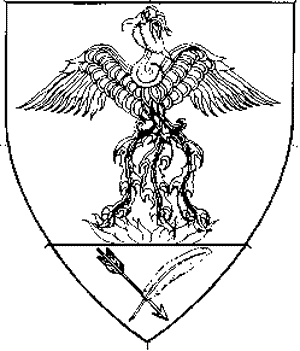 |
Azure, a phoenix Or and in base and arrow and quill in saltire The submitter will not accept major changes, cares most about language/culture (unspecified), desires a female name, wants her name to be changed to be authentic for Irish Gaelic (time unspecified), and will accept a holding name. The submitter provided a copy of the St. Gabriel report #2612 (http://www.s-gabriel.org/2612) (copies attached). In this report, the Academy found Alis during the 13th century in Mari Elspeth nic Bryan's "Index of Names in Irish Annals" (http://www.s-gabriel.org/names/mari/AnnalsIndex/). The Academy found Ruaidhrí between 785 and 1598 in Mari Elspeth nic Bryan's "Index of Names in Irish Annals" (www.s-gabriel.org/names/mari/AnnalsIndex/). Ruaidhrí is the masculine nominative form of this name. The genitive form, used in forming patronymic bynames, is the same spelling. On the device, the arrow and quill are on a base Or. The arrow is argent, fletched azure and possibly headed sable; the quill is azure with an argent spine, leaving the lower portion of the quill entirely argent. |
|
| 2. Cerdic Wlfraven | Dragons Laire | Name and Device, New |
 |
Vert a wolf statant to sinister Argent and in chief a sun in splendor. The submitter will not accept any changes, desires a male name, does not want authenticity, and will accept a holding name. Cerdic is found in Withycombe, E.G. Oxford Dictionary of Christian Names, s.n. Cedric. Withycombe states that this is the name of the traditional founder of the West Saxon kingdom. Wlfraven is documented from François la Flamme's precedents (Arianna Wolfraven, November 2001). This precedent clearly cites Bardsley, Charles, A Dictionary of English and Welsh Surnames, s.n. Wolfraven, dating Wlfraven to 1273 (copies attached). The sun in chief is Or. |
|
| 3. Chuluun the Scribe | Wealdsmere | Name and Device, New |
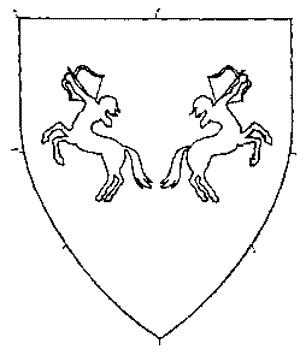 |
Gules, two centaurs addorssed maintaining drawn bows Or. The submitter will not accept major changes, cares most about meaning (stone/rock), desires a male name, wants his to be changed to be authentic for Mongolian, and will accept a holding name. Chuluun documented as the Mongolian word for stone in the Lonely Planet's Mongolian Phrasebook, page 37. Lonely Planet states that Mongolian male names often denote masculine qualities and lists Chuluun as a masculine name associated with stone (copies attached). The submitter believes this follows the naming practices described in "Period Mongolian Names" by Baras-aghur Naran (http://www.sca.org/heraldry/laurel/names/mongol.html) The article asserts that tangible objects, including stone, can be used to form a name. |
|
| 4. Duncan MacDuff | Herons Reach | Badge, New |
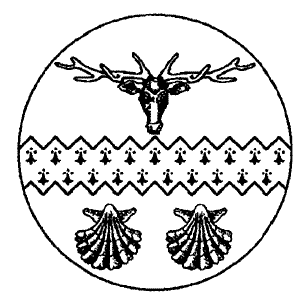 |
Azure, a dance ermine between a hart's head cabossed and two escallops Or. The submitter's name was registered in September 2002. |
|
| 5. Fergus Sturrock | Wealdsmere | Device, New |
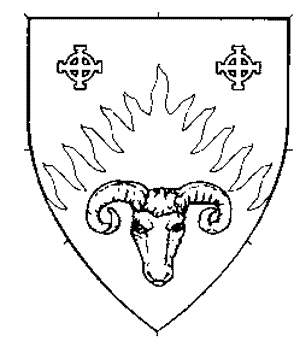 |
Per chevron rayonny argent and gules, a ram's head cabossed and in chief two equal-armed Celtic crosses counterchanged. The submitter's name was registered in October 2003. |
|
| 6. Fiona Finnech | Wealdsmere | Device, New |
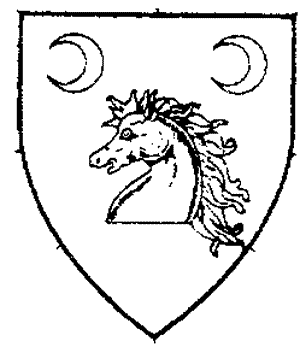 |
Vert, a horse's head couped argent crined and in chief two increscents Or. The submitter's name was registered in July 1993. |
|
| 7. George Frank McKenzie | Bearwood | Name and Device, New |
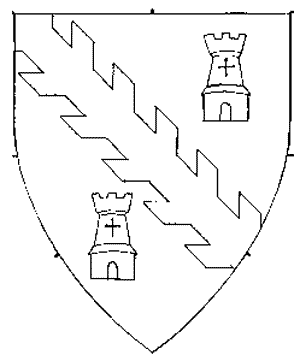 |
Per bend azure and vert a bend raguly between two towers argent. The submitter will accept any changes, cares most about language/culture (Scotland/England), desires a male name, does not want authenticity, and will accept a holding name. George is found in Withycombe, E.G. Oxford Dictionary of Christian Names, s.n. George, dated to 1270. It was also used in the Neville family in the 15th century. Frank is found in Withycombe, E.G. Oxford Dictionary of Christian Names, s.n. Frank, dated as having been used since the 16th century. McKenzie is found in Black, George F. The Surnames of Scotland, page 525. Black gives a Johannes McKenzie with a charter of the lands of Kildin, including mill, in 1606. Other dated forms include Makcainze (1570), Makcanze (1571) and M'Kanze (1544). The bend raguly is Or. |
|
| 8. Grimarr {O,}rv{o,}nd | Three Mountains | Name and Device, New |
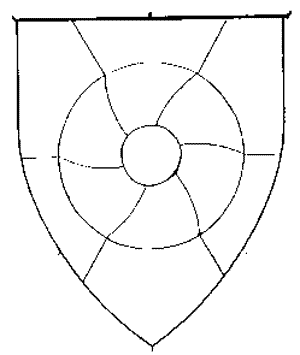 |
Gyronny of six argent and gules on a roundel gyronny arrondy of six sable and argent a roundel gules. The submitter will accept any changes, cares most about meaning (not specified), desires a male name, wants his name changed to be authentic (Norse, no time period specified, and will accept a holding name. Grimarr is found in Geirr Bassi Haraldsson. The Old Norse Name, page 10. {O,}rv{o,}nd is found in Geirr Bassi Haraldsson. The Old Norse Name, page 30. The {o,} is Da'ud notation for an "o-ogonek", being an o with a cedilla/comma under it. |
|
| 9. Gwen Allyn | Three Mountains | Name and Device, New |
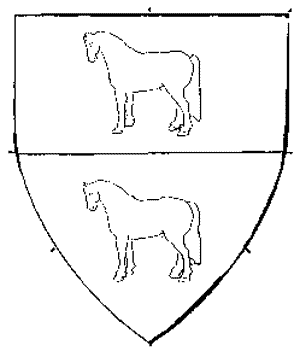 |
Per fess argent et vert two coursers statant, counterchanged. The submitter will accept all changes, cares most about sound, desires a female name, wants her name to be changed to be authentic for 16th century Wales, and will accept a holding name. Gwen is cited from Withycombe, E.G. Oxford Dictionary of Christian Names, s.n. Gwen(da) as meaning white. Allyn is documented from Reaney, P.H. and R. M. Wilson A Dictionary of English Surnames, s.n. Allain, and dated to 1593, Matthais Allyn. |
|
| 10. Kara Bjornsdottir | Wealdsmere | Device Resubmission |
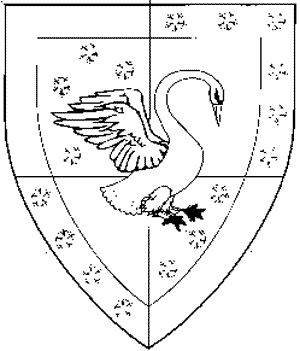 |
Quarterly, Or a semi of roses and purpure, a swan rising sinister wings addorsed inverted argent, a border quarterly purpure and Or a semi of roses purpure. The submitter's name registered in September 2003. The submitter's previous device, Quarterly purpure and sable semy of roses argent, a swan rising sinister wings addorsed inverted argent, a bordure quarterly sable semy of roses argent and purpure, was returned in January 2004 at kingdom for lack of contrast between the bordure and the field. This submission addresses that issue. |
|
| 11. Keterlin von dem Drachen | Glyn Dwfr | Device, Resubmission |
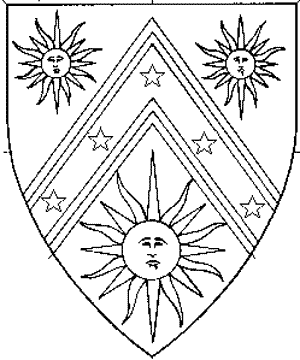 |
Azure, on a chevron cotised between three suns in splendor Or, five mullets Azure. The submitter's name was registered in January 2004. The submitter's previous device was returned in August 2003 at kingdom for conflict with Sorcha inghean Shearraigh (July 2003): Azure, a chevron cotised between three butterflies Or. |
|
| 12. Mederei merc Taran | Danescombe | Name, New |
|
The submitter will not accept any changes, desires a female name, and wants her name to be changed to be authentic for 12th century Wales. Mederei is documented as a female name from Ingraham, Holly's People's Names: A Cross-cultural Reference Guide to the Proper Use of Over 40,000 Personal and Familial Names in over 100 Cultures, page 453, s.n. Mederi. The author asserts to be concentrating on "Old Welsh forms, which are the most ancestral." No actual dates are provided. (copies attached) Taran is documented as a male name from the same source, page 456, s.n. Taran. (copies attached) |
||
| 13. Mountain Edge, Shire of | c/o Shire Seneschal | Badge, New |
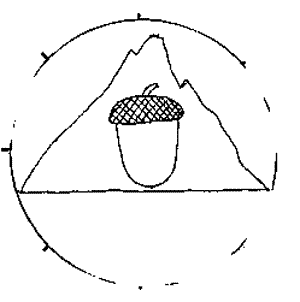 |
(Fieldless) On a mountain couped Or, an acorn proper. The branch's name was registered in July 1995. This badge is to be a populace badge. |
|
| 14. Mychael le Renard change from Michel Renard |
Wealdsmeare | Name, Change |
|
The submitter's current name, Michel le Renard, was registered in May of 1995. The submitter will not accept major changes, cares most about meaning/sound/language/culture (Michael, nothing else specified), desires a male name, and wants his name to be made authentic for French (no time specified). The submitter is only changing his given name from Michel to Mychael. The surname is not being changed and is therefore grandfathered to the submitter. Mychael is documented from Tangwystyl verch Morgant Glasvryn's "Given Names from Brittany 1384-1600" (http://www.sca.org/heraldry/laurel/names/latebreton.html). The author provides Mychael as a form of Michael that was used between the years of 1384 to 1600 in southeastern Brittany. If this name is accepted, the submitter wishes to release Michel le Renard. |
||
| 15. Olivia Dougall | Eisenmarche | Name and Device, New |
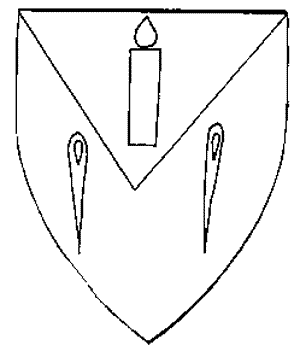 |
Per chevron inverted argent and purpure, a lit candle between two needs counterchanged The submitter will accept any changes, cares most about sound and language/culture (none specified), desires a female name, wants her name to be made authentic (nothing specified), and will accept a holding name. Olivia is documented as a literary name from Shakespeare's Twelfth Night. Dougall is documented form Black, George F. The Surnames of Scotland, s.n. Dougal. Black dates Edward Dougall to 1552. The candle is flamed gules. |
|
| 16. Thorkatla Grafeld | Terra Pomaria | Name and Device, New |
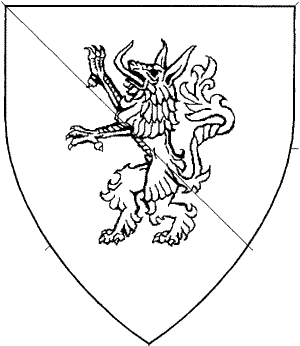 |
Per bend azure and argent, an Alphin salient counterchanged. The submitter will not accept major changes, cares most about language/culture (none specified), desires a female name, wants her name to be changed to be authentic for 900-1300 Scandinavian. Thorkatla is documented from Chapter 34 of The Story of Burnt Njal (Njal's Saga). The copy included does not have a URL or title page to indicate the source it is from. Graefeld is documented from Heimskringla (Chronicle of the Kings of Norway) at http://sunsite.berkeley.edu/OMACL/Heimskringla/grafeld.html. [Webster's note -- this URL is corrected from the printed version of the IL, which had a typo.] This is the byname given to King Harald after he had worn a gray skin given him by a trader. |
|
| 17. Thorkatla Grafeld for House Skraeling | Terra Pomaria | Household Name, New |
|
Her name appears above. The submitter will not accept major changes, cares most about meaning and language/culture (the name Vikings gave the Native Americans), doesn't care about gender, and wants the name changed to be authentic for "Native Americans in the medieval time period who had contact with the Vikings." The submitter states, "Skraeling is the name the Norse (Vikings) gave to the Native Americans in the new world. There is also a Barony of Skraeling Althing. It is in the region of the eastern region of Southern Ontario, including Ottawa, Petawawa, and Kingston." |
||
In service,

Written by: |
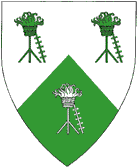
HTML by: |
